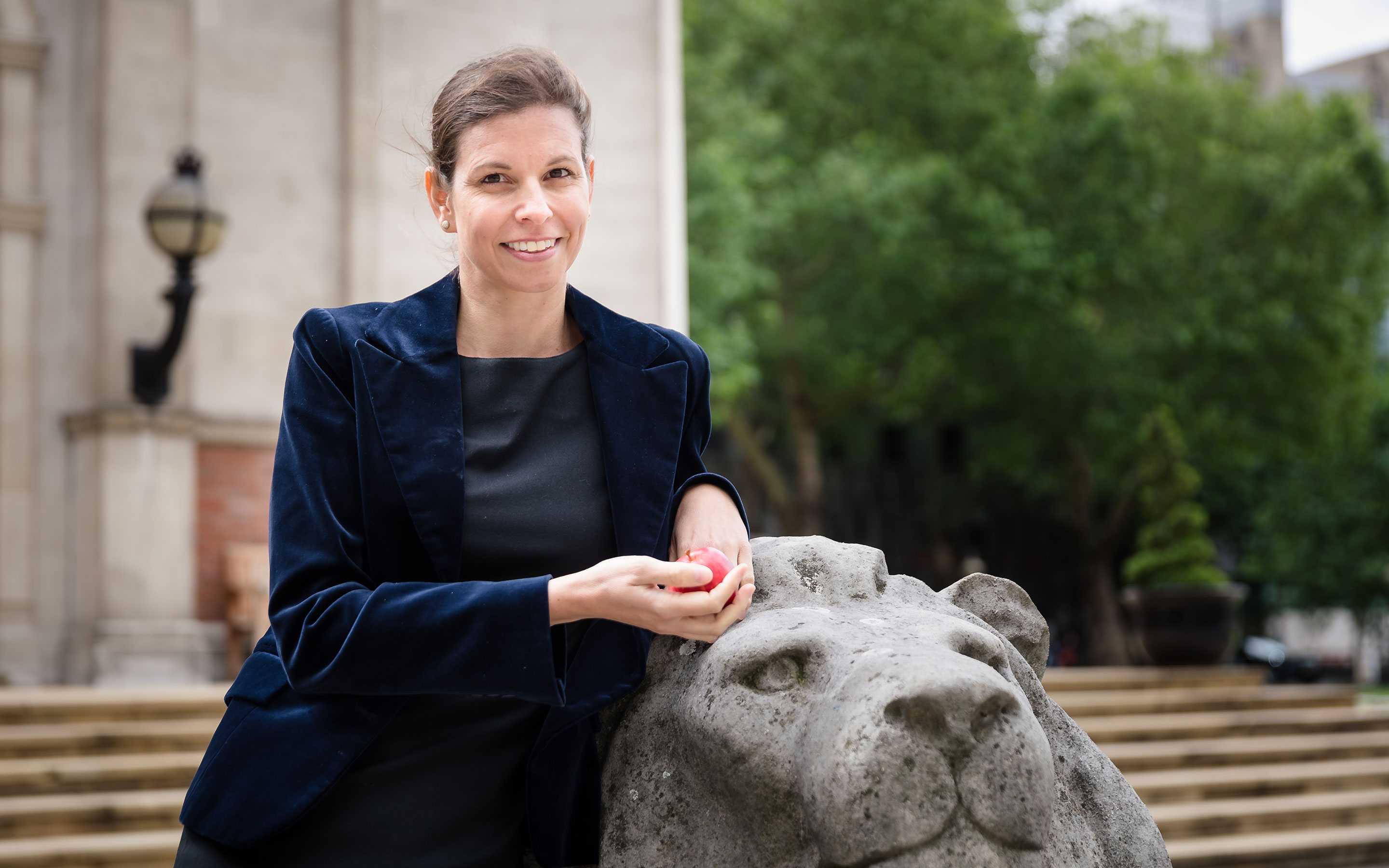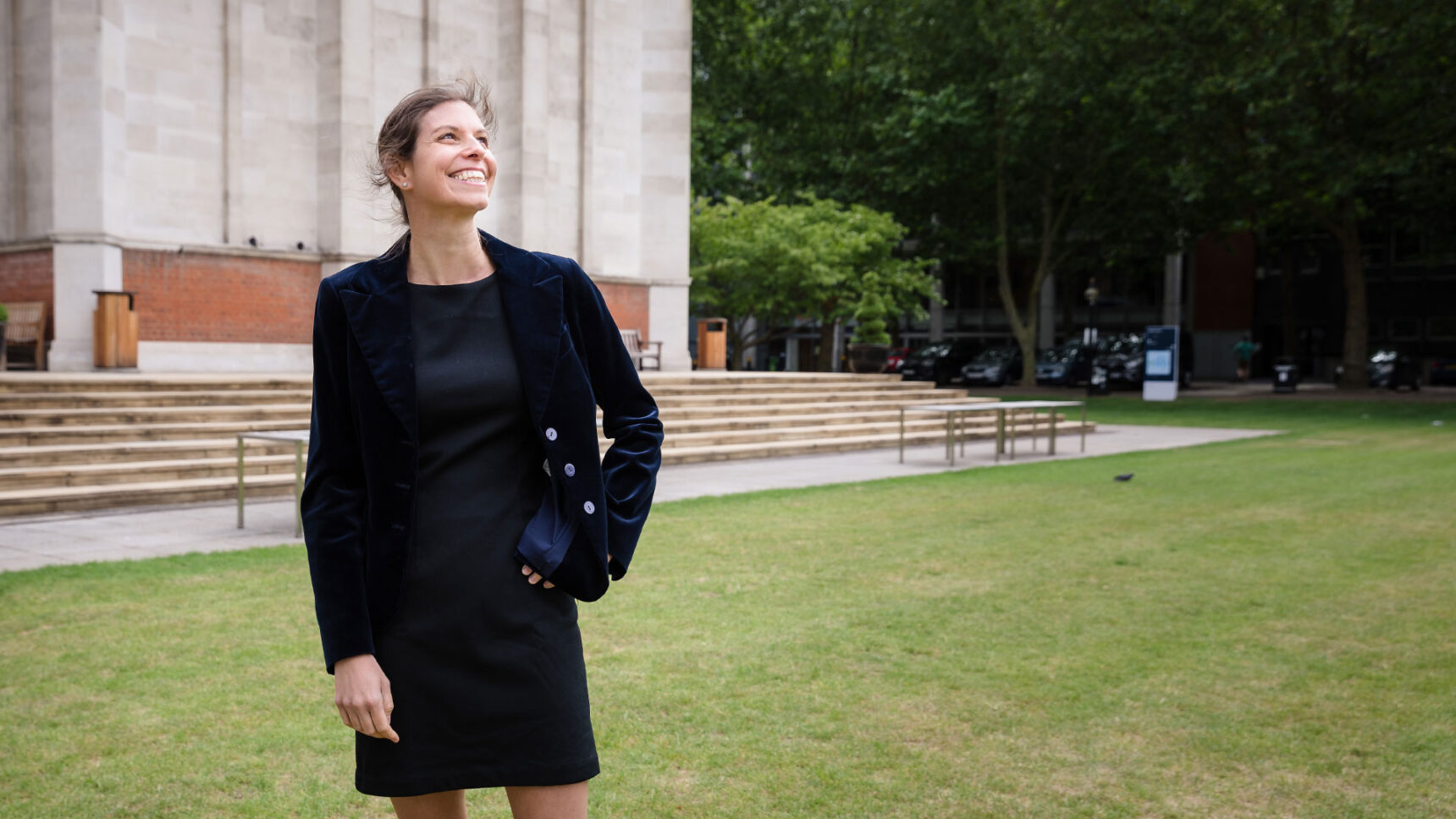The Physicist Who Slayed Gravity’s Ghosts

Claudia de Rham on the campus of Imperial College London.
Philipp Ammon for Quanta Magazine
Introduction
Ever since Albert Einstein’s general theory of relativity recast gravity as curves in space-time, physicists have wondered if his work was the final word. Prodding and tweaking, they’ve tried to modify or even replace Einstein’s gravity, all the while keeping their models within the ever-tighter confines of observation.
Many of these ideas attempt to recast gravity in the language of quantum mechanics, where hypothetical particles called gravitons carry the gravitational force. These gravitons are massless, which means they can, in theory, travel an infinite distance, just as photons (the carriers of the electromagnetic force) let us see to the edges of the universe.
But there’s another possibility. In the 1930s, Wolfgang Pauli and Markus Fierz proposed a graviton with mass. The idea became more plausible in the 1970s, after physicists discovered that massive particles carry the weak and strong forces. Why couldn’t the force of gravity work in the same way?
But “ghosts” soon plagued these theories of massive gravity.
In our familiar world, in order to move an object you have to give it some energy. But in these massive-gravity models, if you try to move an object you get energy back. This goes against the bedrock principle that energy must be conserved, and it leads to all sorts of problems. “Nothing would prevent the whole universe from going completely crazy because it would cost you less and less energy to become more and more crazy,” said Claudia de Rham, a theoretical physicist at Imperial College London. “We call it a ghost because it’s something that just cannot happen.”
Faced with such an essential flaw, theorists began to lose interest in massive gravity, until de Rham — along with Andrew Tolley and Gregory Gabadadze — published a radical paper in 2011 that overturned the status quo. By adding extra dimensions into models of massive gravity, de Rham and her collaborators were able to avoid the ghosts and rekindle the century-long hope of a mathematically plausible theory.
But why bother with massive gravity at all? De Rham hopes that modifying gravity could resolve one of cosmology’s biggest mysteries: dark energy. Two decades ago, cosmologists discovered that the universe’s expansion appears to be accelerating. Ever since, physicists have puzzled over what might be the cause. A massive graviton — one whose reach doesn’t spread quite all the way across the universe — might be able to explain why the universe acts the way it does.
Most exciting for de Rham is the possibility that gravitational wave detectors can test theories of massive gravity against more prosaic ideas. “Gravitational waves are our chance to test different theories of modified gravity,” said de Rham, “and we need to be ready with predictions.”
Quanta spoke to de Rham at home in London via video call during the COVID-19 pandemic. She was relaxed and smiling, despite having to homeschool her three children while keeping up her research and teaching commitments. She sought refuge from her children in the bedroom and we talked for two hours, de Rham’s expressive and energetic hand gestures articulating the evolution of the cosmos and occasionally colliding with the webcam. The interview has been condensed and edited for clarity.

Philipp Ammon for Quanta Magazine
You’ve dedicated your career to studying gravity. Why is it so important?
Gravity is the force that governs the whole evolution of the universe. The laws of gravity tell you how the universe responds to matter and energy — it’s really overarching. If we had switched gravity off at the beginning of the universe, it would still be a big, boiling hot soup of fundamental particles. There would have been no structure: no galaxies, no stars, no planets — nothing to think about.
Then on a fundamental level, in Einstein’s theory of general relativity, the whole notion of space and time comes from gravity. Everything is ultimately embedded within gravity.
Have you always been fascinated by the cosmos?
When I was a child, my parents moved around a lot. I spent most of my childhood in Madagascar, but I also lived in Peru for a while, and then Rwanda. If you don’t really have a home, you have more of an idea of the Earth as a whole. So I had a passion for the sky from this idea that we’re very small entities on Earth, and that the Earth is itself a very small entity in the universe. And then I started trying to understand: What is this universe that surrounds me?
You once trained to be a pilot, and you went through several stages of the European Space Agency astronaut selection process. Do you see yourself as an adventurer?
I would have loved to be an astronaut. Being an astronaut is the ultimate idea of looking into what surrounds us by going there. I also went scuba diving from an early age, and it’s the same idea: you’re exploring new things that are unknown to you by putting yourself physically in them, rather than exploring through data and images. You’re really observing — you’re part of it — and that completely changes your perspective.
Einstein’s general relativity seems to work so well. Why do we need to modify gravity?
After the Big Bang, the universe expanded and cooled down. And we expect this expansion to gradually slow down because the universe has things like galaxies inside it, and they are attracted to each other by gravity. But in the past 25 years or so, observations have shown precisely the opposite: The expansion of the universe is speeding up. It’s accelerating. This is the concept of dark energy, and it points to something that we are missing in our description of the universe.
Dark energy is sometimes seen as this mysterious, magical source of energy that accelerates the expansion of the universe. But this isn’t really the core of the problem. We can cook something up for dark energy — just as we do for dark matter — and hope we’ll detect it later. It’s not particularly satisfying, but we do this, we’ve done it before. Really, the core of the problem is that there’s a complete mismatch in the amount of dark energy that we need to solve this problem and what is a natural amount of dark energy.
The energy density of dark energy is ridiculously small. It’s so small that if you change it by a tiny amount, it makes a huge change to how the universe would have evolved, to the point that no structure would have formed and we wouldn’t exist. It makes me very uneasy to think that we are so dependent on such a precise tuning — to some 120 decimal places. It’s unprecedented in the history of science.
We’re coming up with such a ridiculous answer that it really forces us to reinvestigate every single assumption that we made along the way to get there.
Such as?
You can think about changing Einstein’s equations of general relativity in two ways. The right-hand side of the equations describes the contents of the universe — anything that has mass and energy. On the left-hand side you have what’s called the metric tensor, which describes the curvature of space-time.
When you think of dark energy, you’re adding new stuff to the right-hand side, but this just mathematically describes your lack of knowledge. You’re not really adding new insight.
When you modify gravity, you’re trying to go back to the roots of what space-time is — the left-hand side — and seeing if there’s a modification that makes sense. You’re exploring what the nature of gravity is, deep down.
What sorts of modifications make sense?
It’s useful to make an analogy with electromagnetism, which we think of as a force mediated by a particle called the photon. The photon is massless, and so electromagnetism has an infinite range. This doesn’t mean that if you’re an infinite distance away you will feel these forces — they still die out — but there’s no sharp cutoff. It’s just a gradual decay.
In Einstein’s theory of general relativity, you think of the graviton as a massless particle, and so the force of gravity also has an infinite range. Any modification of gravity means that at some point, a transition occurs. Essentially, the force of gravity switches off at very large distances. So there’s no longer a reason to expect the expansion of the universe to slow down.
You spend your time absorbed in Einstein’s equations. What attracts you to general relativity?
The more I study these equations, the more I realize their beauty and depth. Einstein built general relativity on some pillars called Einstein’s principles. One is the equivalence principle: The laws of physics surely shouldn’t depend on who’s observing that physics. Right? It sounds like something we would want in our theory, but it’s a big assumption that’s set from the beginning.
Now we’re realizing how much more fundamental these principles are. When you start thinking about gravity in terms of gravitons, you find that all of these pillars actually emerge just by requiring the theory to be stable. In order to have structure in the universe, in order for us to exist, you also need to have this beautiful symmetry — that there’s no special observer.
Another thing I find amazing about general relativity is that it tells you precisely when it stops working. Out of the laws of general relativity come black holes. From the outside, we think of a black hole as an object which is so massive that even light cannot escape. Then if you go inside the black hole, you reach a point where space-time has infinite curvature — called a singularity. Here general relativity breaks down. It’s the same thing for the Big Bang singularity too. If you go back in time you reach a point where the curvature of the universe is infinite. And that’s just general relativity telling us: “OK, don’t trust me anymore. I’m out of control.” So we know that general relativity is emerging from something more fundamental.
Yet general relativity appears to describe the rest of the universe pretty well, right?
You want to modify gravity in such a way that you’re not spoiling all of the predictions, and the matching observations, that general relativity has achieved so far.
So any change has to be tiny?
That’s right. For example, if the graviton has a mass, it would have to be very small — far smaller than the neutrino, the lightest massive particle we know of.
How do you test general relativity against theories of modified gravity?
First we can think about how slight modifications of gravity would affect the motion of planets in the solar system. Some of the strongest constraints you have on those models are within the solar system, because we understand gravity so well here.
What about gravitational waves?
Just from the first detection of gravitational waves at LIGO — the Laser Interferometer Gravitational-Wave Observatory — we could already put a bound on how light the graviton must be.
When two black holes or neutron stars merge, they rotate around each other faster and faster, getting closer and closer together. And they make gravitational waves whose frequency is related to how fast the two objects are moving, so that the frequency gets a little bit higher as they merge.
In general relativity, the waves should travel at the same speed no matter what the frequency. Whereas for massive gravity, the speed of the gravitational wave depends on the frequency. It’s a very small effect, but gravitational waves have been observed with such high precision that we can already say that the graviton mass must be less than 10−21 electron volts. [Editor’s note: That’s about 26 orders of magnitude lighter than an electron.] That’s incredible! It’s much more precise than the bound on the mass of the photon — and we’ve been studying light for hundreds of years.
As more models are ruled out, does general relativity seem more appealing?
Over the past 20 years, I’ve learned that Einstein’s theory of gravity is probably the correct description of the universe at low energies — and so perhaps we shouldn’t modify it.
But if we want to state that, we need to have alternatives to compare general relativity to. This is just the scientific approach. We can’t claim that general relativity is the correct description of what’s going on without imagining it in a larger class of models. Only then will we be able to say that we really understand general relativity, that we know that it’s unique, and that it’s the correct description.
Editor’s note: A few weeks after this interview, Claudia de Rham was named a Simons Investigator by the Simons Foundation, the organization that also funds this editorially independent magazine. Simons Foundation funding decisions have no bearing on our coverage. Please see this page for more details.
Correction: August 20, 2020
A note in this Q&A originally stated that the graviton must be at least 1026 orders of magnitude lighter than the electron. It’s light, but not quite that light: The correct figure is 26 orders of magnitude.




